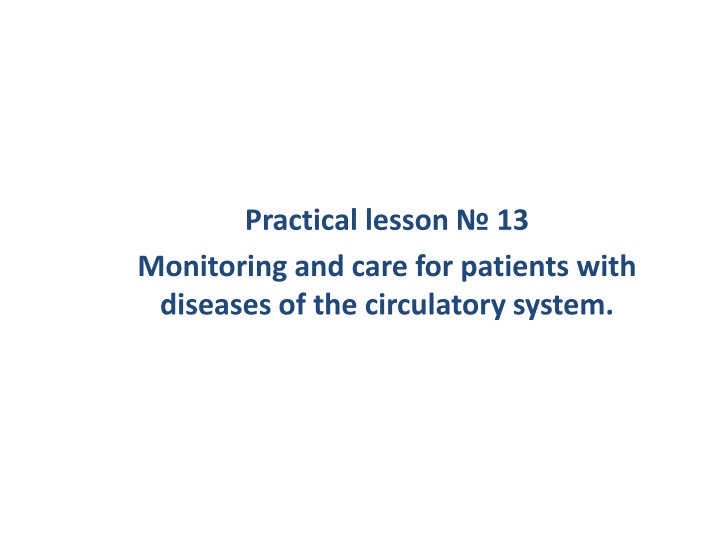
Monitoring and Care for Patients with Circulatory System Diseases
Learn about monitoring and caring for patients with circulatory system diseases, including recognizing symptoms, assessing pulse and blood pressure, and understanding systemic, pulmonary, and coronary circulation. Gain practical skills such as palpating pulse and measuring blood pressure to provide optimal nursing care.
Download Presentation

Please find below an Image/Link to download the presentation.
The content on the website is provided AS IS for your information and personal use only. It may not be sold, licensed, or shared on other websites without obtaining consent from the author. If you encounter any issues during the download, it is possible that the publisher has removed the file from their server.
You are allowed to download the files provided on this website for personal or commercial use, subject to the condition that they are used lawfully. All files are the property of their respective owners.
The content on the website is provided AS IS for your information and personal use only. It may not be sold, licensed, or shared on other websites without obtaining consent from the author.
E N D
Presentation Transcript
Practical lesson 13 Monitoring and care for patients with diseases of the circulatory system.
MONITORING AND CARE FOR PATIENTS WITH DISEASES OF THE CIRCULATORY SYSTEM CONTROL QUESTION The main complaints of patients with diseases of the circulatory system. Characteristics of pain in the heart region. Signs of cardiac edema. Cavity edema. Type cavity edema. Blood Pressure, Systolic and Diastolic pressure, Pulse pressure. Abnormal heart rhythm. Standard of nursing Care patients with diseases of the circulatory system. rterial pulse. Characteristics of the Pulse: the rate, rhythm, volume, tension. Nursing care for edema (Determination of water balance; Weighing the patient; Total care for skin on the feet). PRACTICAL SKILLS Palpation of pulse. Technique of determination of the pulse on the carotid artery. Measurement blood pressure.
The pumping action of the heart usually maintains a balance between cardiac output and venous return. Cardiac output (CO) is the amount of blood pumped out by each ventricle in one minute. The cardiac cycle refers to events that occur during one heart beat and is split into ventricular systole (contraction/ejection phase) and diastole (relaxation/filling phase).
Systemic Circulation Systemic circulation carries highly oxygenated blood from the left side of the heart to all of the tissues of the body (with the exception of the heart and lungs). Systemic circulation removes wastes from body tissues and returns deoxygenated blood to the right side of the heart. The left atrium and left ventricle of the heart are the pumping chambers for the systemic circulation loop.
Pulmonary Circulation Pulmonary circulation transports deoxygenated blood from the right side of the heart to the lungs, where the blood picks up oxygen and returns to the left side of the heart. The pumping chambers of the heart that support the pulmonary circulation loop are the right atrium and right ventricle.
Coronary Circulation The heart has its own set of blood vessels that provide the myocardium with the oxygen and nutrients necessary to pump blood throughout the body. The left and right coronary arteries branch off from the aorta and provide blood to the left and right sides of the heart. The coronary sinus is a vein on the posterior side of the heart that returns deoxygenated blood from the myocardium to the vena cava.
The main complaints Heart pain Dyspnea Abnormal heart rhythm Change in blood pressure (increase of blood pressure or decrease of blood pressure) Edema
Characteristic of heart pain Reasons and conditions of pain occurrence Pain may be provoked by physical or mental stress that increases the heart's demand for blood. Localization of pain Pain is localized behind the sternum (breastbone) or slightly to the left of the sternum. Nature of pain: burning sensation constricting pain pressing pain. Irradiation (spreading) of pain Pain commonly irradiates to the region under the left scapula, the neck, and the left arm. The pain is usually removed by nitroglycerin or after a rest.
Edema in cardiac patients appears in case of development of heart failure. Heart failure - a reduction of myocardial contractility, resulting in the development stagnation of blood in the systemic circulation and fluid retention in the body.
Signs of cardiac edema: Edema are localized in legs Edema can spreads upwards (foot, shin, thigh, down to the groin). In a first stage of Heart failure edema appears in the evening and disappears in the morning. Consistency of edema is dense like a dough (there is a fossa after pressing).
In advanced cases of heart failure fluid (transudate) may accumulate in serous cavities. It is cavity edema. The fluid that accumulates in the serous cavities is called transudate. Type cavity edema: Hydrothorax Hydropericardium Ascites Anasarca - a generalized infiltration of edema fluid into subcutaneous connective tissue
Dyspnea - is one of the signs of acute or chronic heart failure. The patient has a painful feeling of shortness of breath during physical exertion and excitement, and as the disease progresses and at rest. 1. Dyspnea cardiac origin is inspiratory (difficulty while inhale). 2. Dyspnea occurs during exercise, later at rest 3. Dyspnea disappears after rest
Changes blood pressure Increase of blood pressure Decrease of blood pressure) Hypertension (hypertensive disease) Blood pressure rises rapidly and sharply Increases systolic BP High pulse pressure The patient feels increased blood pressure (pain, etc.)
rterial pulse Arterial Pulse is an alternate expansion (rise) and recoil (fall) of an artery as artery as the wave of blood is forced through it during the contraction of the left ventricle. The pulse can be felt by the fingers on a point where an artery crosses a bone close to the surface of the skin.
Abnormal heart rhythm Patient feels interruption in work of heart Deviations from normal heart rhythm are called arrhythmia.
Standard of nursing Care: 1. Physical Examination (collection of information, Regular measurement of the basic hemodynamic parameters - blood pressure and pulse) 2. Diagnostic Studies (preparation for instrumental laboratory and studies) 3. Psychological support (Creation of psychological comfort by the hospital staff in the medical ward; Creation of psychological comfort for relatives of the patient.) 4. Control of physical activity in accordance with its tolerance (Check the position of the patient's body in bed; Therapeutic exercises). 5. Nursing care for edema (Determination of water balance; Weighing the patient; Total care for skin on the feet). 6. Pharmacological therapy (Control of the regular intake of medicines). 7. Nutrition (diet 10). 8. Advice to patient (Education). 9. First Aid & Emergencies (predoctor care).
Sites for taking pulse. The pulse may be felt at: 1. The radial artery in front of the wrist. 2. Temporal artery over the temporal bone. 3. Carotid artery at the sides of the neck. 4. The brachial artery above the elbow and in the antecubital fossa (inner part of the elbow). 5. Femoral artery in the groin. 6. Poplitial artery in the poplitial fossa (back of the knee). 7. The dorsalis pedis artery on the foot. 8. The posterior tibial artery behind the medial malleolus.
Palpation of pulse Palpation of the pulse is a simple and quick method study of cardiac activity, does not require special equipment. Characteristics of the Pulse Before assessing the pulse, nurse must determine the normal characteristics of a pulse: the symmetry of the pulse rhythm, the rate, volume tension.
Symmetry of the pulse Pulse can be symmetric and asymmetric. In norm pulse wave should be the symmetric (same) on symmetrical arteries. In pathology of the pulse may be asymmetrical (different) on symmetrical arteries. In this case we are talking about only about the weakening of the pulse on one of the arteries. The asymmetry of the pulse. Reasons: poor circulation as a result of atherosclerosis of this artery or compression from the outside.
Rhythm Rhythm refers to the regularity of beats. May be regular and irregular Rhythm of the pulse. Normally the heart beats are spaced at equal intervals and they are said to be regular. Regular rhythm - interval between heartbeats same. Irregular rhythm - interval between heartbeats different. If an irregularity is present, the pulse should be counted for one full minute.
Rate Rate is the number of pulse beats in a minute. The normal rate in the resting adult is 60 to 100 per minute normocardia . A pulse rate over 100 per minute is referred to be "tachycardia". A pulse rate below 60 per minute in an adult is referred to be "bradycardia".
The factors causing variations in pulse rate are: Age: The very young have a rapid pulse rate. The adults have a normal range of 70 to 80 per minute. The very old have relatively slow pulse rate. Before birth - 140 to 150 per minute, 130 to 150 per minute. At birth (Newborn) - 115 to 130 per minute. First year - 100 to 115 per minute. Second year - 90 to 100 per minute. Third year - 86 to 90 per minute. 4 to 8 years - 80 to 86 per minute. 8 to 15 years - 70 to 80 per minute. Old age - 60 to 70 per minute. Sex: The female has a slightly more rapid pulse than the male. Physique: The short person with small body build has a slightly more rapid pulse than the tall heavy individual. Exercise: Increased muscular activity will increase the pulse rate. Food: Indigestion of food causes a slight increase in the pulse rate for several hours. Posture: The pulse rate is higher when the body is in standing position than when in sitting or reclining position. Emotions: Mental or emotional disturbances will increase pulse rate temporarily. Application of heat: Application of heat can increase the pulse rate. Pain:A client in the agony of pain will have increased pulse rate. Increased body temperature: When the body temperature is elevated the pulse rate tends to rise. Disease conditions: Loss of blood, injury to the viscera, shock etc., increase the pulse rate. Heart diseases, typhoid, infection etc., have a marked effect on the pulse rate. In heart diseases the pulse rate may be either rapid or slow according to of cardiac lesions. In typhoid fever, the pulse rate tends to be slow. Drugs: Stimulant drugs e.g., caffeine, atropine, thyroid adrenaline etc., will raise the pulse rate. Administration of sedative drugs can reduce the pulse rate. Cold applications: The cold applications can reduce the pulse rate. Hypothermia can reduce the pulse rate to a very lower rate.
Volume Volume refers to the fullness of the artery. It is the force of the blood felt at each beat. Volume depends upon the amount of blood in the arteries. If the arteries contain a norm volume of blood, the pulse is said to be satisfactory in volume. If the arteries contain a large volume of blood, the pulse is said to be full in volume. If the volume of the blood is decreased (as by haemorrhage, shock, or loss of fluid from the body, e.g., diarrhoea and vomiting) the pulse will be weak thereby small weak pulse (thready - at very low BP).
Tension Tension pulse is formed by pressure of blood on an artery wall. Tension is the degree of compressibility. If pulse disappears at a moderate compression of a radial artery, such pulse characterize as pulse of a satisfactory tension. When the artery is difficult to compress - pulse of high tension When the artery is easy to compress low - pulse of tension. In typical cases (in the healthy person) pulse rate 60-90 per minute, regular, satisfactory tension, full in volume.
Pulse assessment Most often A doctor or nurse checks a patient's pulse at the bilateral radial artery. Purpose Pulse assessment is performed to establish a baseline on a patient's admission (from which to compare any significant changes), and to detect any abnormalities from the healthy state. Equipment The equipment required for pulse assessment is a watch with a sweep second hand. Algorithm 1. Wash your hands. 2. Patient should be sitting or lying comfortably. 3. The patient's forearm should not be raised to a level higher than the heart. 4. Stand to face the patient. 5. The nurse should place the index, middle, and ring fingers over the radial artery, the thumb on the outer side of the forearm. 6. First the examiner should determine if the pulse can be equally felt on both arms. To that end both radial arteries should be palpated simultaneously he magnitude of pulse waves on both hands compared (normally it is the same). 7. Determine pulse rate and rhythm: Using a watch the pulse are counted for half a minute, and the result doubled to give the beats per minute. However, if an irregular rhythm, the pulse are counted for one full minute. 8. Determine Tension and Volume of pulse: Apply pressure at artery, then release your finger. 9. Wash your hands. 10. Record the results of the study of the pulse.
TECHNIQUE OF DETERMINATION OF THE PULSE ON THE CAROTID ARTERY In severe condition of the patient assess the presence of a pulse in the external carotid artery. Algorithm: 1. Rotate the patient's head in the opposite direction. 2. Define on a forward surface of a neck the most acting part of a thyroid cartilage - so-calledAdam's apple. 3. Shift the index and middle fingers from the cartilage to the outside. 4. Place the fingers at the inner side of the sterno-cleido-mastoid muscle. 5.Use your fingertips to determine the pulsation of the carotid artery. The study should be carried out carefully (on the one side) , you cannot pinch the carotid artery, as it is rich reflexogenic zone and there is a risk of acute reflex slowing heart rate up to the loss of consciousness patients.
Blood Pressure Blood pressure is the pressure exerted by the blood against the walls of the blood vessels as it flows through them. Systolic pressure is the highest degree of pressure exerted by the blood against the walls of the blood vessels during the ventricular systole when the left ventricle is forcing the blood into the aorta. Diastolic pressure is the lowest pressure that occurs when the heart is in its resting period just before the contraction of the left ventricle. Pulse pressure is the difference between the systolic and diastolic pressure and represents the volume output of the left ventricle. The average blood pressure for the healthy adult is usually about 120/80 mm Hg. A systolic pressure above 140 or below 90 mm Hg is regarded as abnormal. Hypertension is a condition of abnormally high blood pressure (above 140/90 mm Hg ). Hypotension is a condition of abnormally low blood pressure (below 100/60 mm Hg .
Measurement BP - an important control method behind a condition of a hemodynamic at healthy and at sick people. Measurement of a BP can be carried out direct and indirect methods. The direct method assumes introduction of the sensor immediately in a blood channel. This method apply for the purpose of determination of pressure in large vessels or heart cavities. In daily practice of a BP is measured by the indirect auscultation method offered in 1905 by the Russian surgeon Nikolay Sergeyevich Korotkov.
Steps of procedure - MEASUREMENT OF BP 1 . Wash hands. 2. Take the equipment to the bedside: A quality stethoscope . An appropriately sized blood pressure cuff . A blood pressure measurement instrument. 3. The patient should sit upright or lie. 4 . Wrap the cuff around the patient's arm. 5. Palpate/locate the brachial artery. 6. place the bell of the stethoscope on the brachial artery. 7. close the valve on the pump by turning the knob clockwise. 8. Pump up air in the cuff until the sphygmomanometer registers about 20 mm above the point at which the radial pulsation disappears. 9. Open the valve slowly by turning the knob anti clockwise. Permit the air to escape very slowly. Note the number on the manometer where the sound first begins. This is the systolic pressure. 10. Continue to release the pressure slowly. The sound become louder and clearer. Note the point on the manometer where the sound cease. This is the diastolic pressure. 11. Allow the air to escape and the mercury to fall zero. Wait for 1 minute with the cuff deflated. 12. Repeat the procedure if there are any doubts about the reading. 13. Do not take blood pressure more than three times in succession on the same arm. .
Steps of procedure - MEASUREMENT OF water balance Purpose: diagnostics of the hidden edemas 1. At 6 a.m. the patient urinates into the toilet. After that the patient urinates in bedpan. 2. Nurse ounts the amount of liquid arriving in an organism per day. Water, tea, juice plus amount of fluid, which the nurse entered into a vein. 3. Nurse ounts the amount of excreted urine per day. 4. Determine OF water balance. Calculation of the water balance is determined by a formula: The amount of urine*100 Total amount of fluid 5. To consider water balance is negative if less liquid is emitted, than it is calculated in norm (+ or 5 - 10% may be) 6. To consider water balance is positive if more liquid is emitted, than it is calculated. 7. To make records in a leaf of the accounting of water balance.
Algorithm determining of water balance (daily diuresis): 1. at 6 a.m. the patient urinates into the toilet. 2. after that the patient urinates in bedpan. 3. nurse measures the volume of urine. 4. nurse calculates (nurse counts), the amount of fluid which the patient drank for 24 hours (water, tea, juice). Plus amount of fluid, which the nurse entered into a vein. 5. Determine of water balance.
For example: ACCOUNT SHEET Calculation of the water balance is determined by a formula: 1830 * 0,8 = 1464 ml Patient - Ivanov I. Ward 15 Count amount of liquid arriving in an organism per day. Breakfast 300 ml 10.00 200 ml 11.00 150 ml Lunch - 600 ml Dinner 180 ml 21.00 200 ml 22.00 200 ml In total 1830 ml Count amount of excreted urine per day: 300 ml 220 ml 250 ml 350 ml 280 ml In total 1400 ml






















